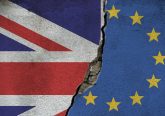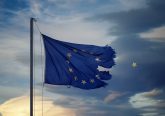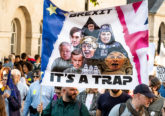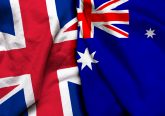As the Bremain and Brexit campaigns gear up for the last three days of campaigning, the outcome remains far from clear. Recent polls show the vote tied at 50/50. Both sides of the argument have heralded the referendum as a “unique event”. Unique as it may be for this generation of UK citizens, referenda of this kind are not singular. In fact, the UK’s referendum on EU membership, to be held on 23 June, shares a number of remarkable parallels with Spain’s in-out NATO referendum, held thirty years earlier on 12 March 1986. Let’s review the similarities one-by-one.
-
The “question”: stay or leave NATO/the EU.
Spain joined NATO in May 1982. Four years later, in March 1986, the Spanish Socialist Workers’ Party (PSOE) called an in-out NATO referendum. The popular narrative in Spain, however, is that the 1986 referendum was about accession and not about continued membership. But as President González of Spain himself put it in the NATO referendum campaign: ‘It’s one thing not to marry [NATO], it’s another thing to divorce [NATO]’.
Last month, former Prime Minister Tony Blair made a similar argument: ‘this is a question about whether we leave Europe, not whether we join Europe’, he said on the Andrew Marr show.
-
The Spanish Socialist Workers’ Party (PSOE)/Conservative Party used an anti-NATO/anti-EU discourse in the general election campaigns prior to the referenda.
José María Maravall, who holds an Oxford DPhil and sat on the PSOE governing body, campaigned against Spain’s NATO membership in the 1982 general election campaign, as did Javier Solana, who later went on to become NATO secretary-general between 1995 and 1999.[1] The PSOE won a landslide victory in the 1982 election with 202 out of 350 seats in Parliament.
The Conservative Party told anti-Europeans that a vote for Mr Cameron was the only way to ensure that Britain had a chance to reject EU membership. Clear anti-EU statements throughout the Conservative Party’s 2015 general election campaign were that the EU ‘is too big, too bossy and too bureaucratic’ and that the UK should ‘reclaim power from Brussels.’ The Conservative Party secured a majority of 331 seats in the 2015 general election.
-
‘The people must decide’: The PSOE/Conservative Party general election manifestos promised to hold a referendum.
The PSOE 1982 general election manifesto included the following statement: ‘The PSOE will keep its promise to hold a referendum, so that the people may decide on Spain’s NATO membership.’
The Conservative Party 2015 general election manifesto made a similar pledge: ‘We will give you a say over whether we should stay in or leave the EU, with an in-out referendum by the end of 2017… It will be a fundamental principle of a future Conservative Government that membership of the European Union depends on the consent of the British people—and in recent years that consent has worn wafer-thin. That’s why, after the election, we will negotiate a new settlement for Britain in Europe, and then ask the British people whether they want to stay in the EU on this reformed basis or leave.’
-
General election ambiguity
The PSOE/Conservative Party general election manifestos made no mention to whether the party/government would campaign to leave or stay in NATO/the EU.
-
The PSOE/Conservative governments negotiated terms with its NATO/EU partners prior to the referenda.
In December 1985, three months before the referendum, the US and Spain signed a memorandum of understanding. The agreement stated that Spain would take on some of the US’ responsibilities on a task-by-task basis without compromising overall Western security. This was the first step to negotiating US troop reductions in Spain. The agreement was intended to appease discontented voters and to prove that González’s government was truly committed to the three conditions on which it campaigned to stay in NATO: i) Spain would not enter the military command structure; ii) it would remain non-nuclear; and iii) US military deployment in Spain would be reduced.
In February 2016, four months before the referendum, the EU and Britain reached an agreement. One of the key points included in the deal is an “emergency brake” on migrants’ in-work benefits for four years when there are “exceptional” levels of migration. The UK will be able to operate the brake for seven years. The agreement also stipulates that child benefits for children of EU migrants living overseas will now be paid at a rate based on the cost of living in their home country—applicable immediately to new arrivals and from 2020 to the 34,000 existing claimants. Moreover, the EU treaties will be amended to state explicitly that references to the requirement to seek ever-closer union ‘do not apply to the United Kingdom’, meaning Britain ‘can never be forced into political integration’. Finally, the UK will be allowed to enact “an emergency safeguard” to protect the City of London, to stop UK firms being forced to relocate to Europe, and to ensure British businesses do not face “discrimination” for being outside the Eurozone.[2]
-
Eventually, the PSOE/Conservative Party governments campaigned to stay in NATO/the EU.
-
‘The national interest’ played a prime role in the “Remain” campaigns.
The PSOE’s remain campaign slogan was ‘Vote yes in Spain’s interest’.
The slogan for Britain Stronger in Europe, the official ‘Remain’ campaign for the referendum, was ‘Britain is stronger, safer and better off in Europe’.[3]
-
The mayor of Madrid/London supported the “Leave” camp: The mayor of Madrid, Enrique Tierno-Galván campaigned to leave NATO. The former mayor of London, Boris Johnson, similarly advocated a Leave vote.
Tierno, a Socialist, campaigned against his party/the government. He led the PSOE’s Socialist Left faction, and was the party’s president from 1978 to 1979. Tierno finally left the presidency when the PSOE decided to give up Marxism in 1979, but not without first trying to run for general-secretary against González. As the mayor of Madrid, Tierno ran several “leave” rallies. During Ronald Reagan’s 1985 visit to Spain, Tierno-Galván organized a massive “leave” rally. US Ambassador Enders believed that ‘the Reagan visit to Madrid last May was linked in the public mind to our pressure on the NATO issue.’[4] This explains why, upon Tierno’s death, six months after Reagan’s visit to Madrid, Enders intimated: ‘at the risk of sounding macabre, (that) it was probably useful Tierno-Galván died two months before the referendum and not two days before.’[5]
London’s former mayor, Boris Johnson, a Conservative figure, is advocating Vote Leave, going against the party leadership and the government. Mr Johnson has come under strong attacks from other Conservative party members, who suggest his decision is inspired by his desire to become the UK’s next Prime Minister.
-
The US urged Spain/Britain to stay in NATO/the EU.
The US did not want Spain to leave NATO, but whether Spain wished to remain in NATO was up to Spain to decide.[6] ‘Having Spain as a member strengthens NATO; I believe it also adds to Spain’s own security,’ said President Reagan.[7]
During his recent trip to the UK, US President Barack Obama supported Mr Cameron’s call for Britain to remain in the EU. ‘The U.K. is at its best when it is helping to lead a strong Europe. It leverages U.K. power.’[8]
Spain is the only country to have held a referendum on withdrawal from NATO. Britain is the only country to hold a referendum on withdrawal from the EU.
On 12 March 1986, 52.53 per cent voted to stay in NATO; 39.84 per cent voted to leave NATO. Spain’s in-out NATO referendum was President González’s ‘most difficult political issue’.[9] Despite having won the referendum, President González thinks it was a huge mistake to hold the referendum in the first place.[10] Will Mr Cameron also regret Britain’s in-out EU referendum?
References
[1] José María Maravall, interview with the author, 9 April 2012. Maravall holds an Oxford DPhil in Sociology and served as Minister of Education in Spain from 1982 to 1988.
[2] ‘EU deal gives UK special status, says David Cameron’, BBC, http://www.bbc.co.uk/news/uk-politics-35616768 Accessed 18 May 2016.
[3] http://www.strongerin.co.uk
[4] Ambassadorial cable, ‘The death of Tierno Galvan’, 21 January 1986, folder Spain 1986 (7 of 7), RAC box 4, Peter Sommer Files, Ronald Reagan Library.
[5] Ibid.
[6] http://www.presidency.ucsb.edu/ws/?pid=38600
[7] Public Papers of the Presidents of the United States: Ronald Reagan, 1985. 557.
[8] https://www.whitehouse.gov/the-press-office/2016/04/22/remarks-president-obama-and-prime-minister-cameron-joint-press
[9] Felipe González, interview with the author, 10 April 2012.
[10] María Antonia Iglesias, La memoria recuperada: Lo que nunca han contado Felipe González y los dirigentes socialistas de sus años de gobierno (Madrid: Aguilar, 2003).






